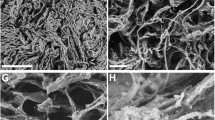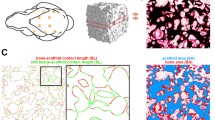Abstract
Objectives
The aim of the present study was to test the hypothesis that the ratio of angiogenic and osteogenic signaling affects ectopic bone formation when delivered in different amounts.
Materials and methods
Porous composite PDLLA/CaCO3 scaffolds were loaded with rhBMP2 and rhVEGF in different dosage combinations and implanted into the gluteal muscles of 120 adult male Wistar rats. Bone formation and expression of alkaline phosphatase and Runx2 were quantified by histomorphometry. Spatial distribution across the scaffolds was assessed by using a grid that discriminated between the periphery and center of the scaffolds.
Results
The evaluation showed that the combined delivery of bone morphogenetic protein BMP2 and VEGF in different dosage combinations did not enhance the overall quantity of ectopic bone formation compared to the delivery of BMP2 alone. The addition of VEGF generally upregulated Runx2 after 4 weeks, which may have retarded terminal osteogenic differentiation. However, slow combined delivery of 1.5–2.0 μg BMP2 combined with 50 ng VEGF165 over a period of 5 weeks supported a more even distribution of bone formation across the implanted scaffolds whereas higher amounts of VEGF did not elicit this effect.
Conclusions
The findings suggest that structural organization rather than the quantity of ectopic bone formation is affected by the dosage and the ratio of BMP2 and VEGF levels at the observed intervals.
Clinical relevance
The development of carriers for dual growth factor delivery has to take into account the necessity to carefully balance the ratio of growth release.









Similar content being viewed by others
References
Bayer EA, Gottardi R, Fedorchak MV, Little R (2015) The scope and sequence of growth factor delivery for vascularized bone tissue regeneration. J Control Release 219:129–140
Kanczler JM, Oreffo RO (2008) Osteogenesis and angiogenesis. Eur Cells Mat 15:100–114
Cui Q, Dighe AS, Irvine JN Jr (2013) Combined angiogenic and osteogenic factor delivery for bone regenerative engineering. Curr Pharm Des 19(19):3374–3383
Patel ZS, Young S, Tabata Y, Jansen JA, Wong ME, Mikos AG (2008) Dual delivery of an angiogenic and an osteogenic growth factor for bone regeneration in a critical size defect model. Bone 43:931–940
Hernandez A, Reyes R, Sanchez E, Rodriguez-Evora M, Delgado A, Evora C (2012) In vivo osteogenic response to different ratios of BMP-2 and VEGF released from a biodegradable porous system. J Biomed Mater Res Part A 100A:2382–2391
Su J, Xu H, Sun J, Gong X, Zhao H (2013) Dual delivery of BMP-2 and bFGF from a new nano-compsite scaffolds, loaded with vascular stents for large size mandibular defect regeneration. Int J Mol Sci 14:12714–12728
Zhang Y, Madhu V, Dighe AS, Irvine JN, Cui Q (2012) Osteogenic response of human adipose-derived stem cells to BMP-6, VEGF and VEGF plus BMP-6 in vitro. Growth Factors 30:333–343
Lohse N, Moser N, Backhaus S, Annen T, Epple M, Schliephake H (2015) Continuous delivery of rhBMP2 and rhVEGF165 at a certain ratio enhances bone formation in mandibular defects over the delivery of rhBMP2 alone—an experimental study in rats. J Control Release 220:201–209
Wang H, Zou Q, Boerman OC, Nijhuis AW, Jansen JA, Li Y, Leeuwenburgh SC (2013) Combined delivery of BMP-2 and bFGF from nanostructured colloidal gelatin gels and its effect on bone regeneration in vivo. J Control Release 166(2):172–181
Geuze RE, Theyse LF, Kempen DH, Hazewinkel HA, Kraak HY, Oner FC, Dhert WJ, Alblas J (2012) A differential effect of bone morphogenetic protein-2 and vascular endothelial growth factor release timing on osteogenesis at ectopic and orthotopic sites in a large-animal model. Tissue Eng Part A 18:2052–2062
Kempen DH, Lu L, Heijink A, Hefferan TE, Creemers LB, Maran A, Yaszemski MJ, Dhert W, J. (2009) Effect of local sequential VEGF and BMP-2 delivery on ectopic and orthotopic bone regeneration. Biomaterials 30:2816–2825
Young S, Patel ZS, Kretlow JD, Murphy MB, Mountziaris PM, Baggett LS, Ueda H, Tabata Y, Jansen JA, Wong M, Mikos AG (2009) Dose effect of dual delivery of vascular endothelial growth factor and bone morphogenetic protein-2 on bone regeneration in a rat critical-size defect model. Tissue Eng Part A. 15:2347–2362
Behr B, Sorkin M, Lehnhardt M, Renda A, Longaker MT, Quarto N (2012) A comparative analysis of the osteogenic effects of BMP-2, FGF-2 and VEGFA in a calvarial defect model. Tissue Eng 18:1079–1086
Zhang W, Zhu C, Wu Y, Ye D, Wang S, Zou D, Zhang X, Kaplan DL, Jiang X (2014) VEGF and BMP-2 promote bone regeneration by facilitating bone marrow stem cells homing and differentiation. Eur Cells Mat 27:1–12
Li CJ, Madhu V, Balian G, Dighe A, Cui A (2015) Cross-tlk between VEGF and BMP-6 pathways accelerates osteogenic differentiation of human adipose-derived stem cells. J Cell Physiol 230:2671–2682
Deckers MML, van Bezoojen RL, van der Hors G, Hoogendam J, van der Bent C, Papapoulos SE, Löwik CWGM (2002) Bone morphogenetic proteins stimulate angiogenesis through osteoblast-derived vascular endothelial growth factor A. Endocrinology 143:1545–1553
Hollinger JO, Kleinschmidt JC (1990) The critical size defect as an experimental model to test bone repair materials. J Craniofac Surg 1:60–68
Schliephake H, Boven J, Backhaus S, Annen T, Epple M (2015) Solvent free production of porous PDLLA/calcium carbonate composite scaffolds for controlled release of rhBMP2 and rhVEGF165. Oral Maxillofacial Surgery 19:133–141
Schliephake H, Weich H, Schulz J, Gruber H (2007) In-vitro characterization of a slow release system of polylactid acid and rhBMP-2. J Biomed Mater Res 83:455–462
Gruber RM, Weich H, Schliephake H (2009) Ectopic bone formation after implantation of a slow release system of polylactid acid and rhBMP2. Clin Oral Impl Res 20(1):24–30
Donath K (1985) The diagnostic value of the new method for the study of undecalcified bones and teeth with attached soft tissue (Sage-Schliff (sawing and grinding) technique). Pathology Research Practice 179:631–633
Khojasteh A, Fahimipour F, Eslaminejad MB, Jafarianm M, Bastami F, Tahiri M, Karkhaneh A, Tayebi L (2016) Development of PGLA-coated β-TCP scaffolds containing VEGF for bone tissue engineering. Mater Sci Eng C Mater Biol Appl 69:780–788
Sacchetti B, Funari A, Remoli C, Giannicola G, Kogler G, Liedtke S, Cossu G, Serafini M, Sampaolesi M, Tagliafico E, Tenedin E, Saggio I, Robey PG, Riminucci M, Bianco P (2016) No identical “mesenchymal stem cells” at different times and sites: human committed progenitors of distinct origin and differentiation potential are incorporated as adventitial cells in microvessels. Stem Cells Rep 14:897–913
Jackson WM, Aragon AB, Bulken-Hoover JD, Nesti LJ, Tuan RS (2009) Putative heterotopic ossification progenitor cells derived from traumatized muscle. J Orthop Res 27:1645–1651
Komori T (2010) Regulation of bone development and extracellular matrix protein genes by RUNX2. Cell Tissue Res 339:189–195
Charles LF, Woodman JL, Ueno D, Gronowicz G, Hurley MM, Kuhn LT (2015) Effects of low dose FGF2 and BMP-2 on healing of calvarial defects in old mice. Exp Gerontol 64:62–69
Acknowledgements
The authors greatly value the help of Mrs. Jutta Schulz and Dr. Behrens during the laboratory experiments and the support of Dr. Sven. Backhaus and Dr. Thomas Annen during the preparation of the scaffolds. They also wish to thank Mrs. Kant and Mrs. Schäfer for their valuable help in histologic processing.
Funding
This work has been funded by a grant from the Federal Ministry of Education and Research (BMBF) (No. 13N10003).
Author information
Authors and Affiliations
Contributions
N. Moser performed the animal experiments, scanned the histologic specimens, and co-authored the manuscript. J. Goldstein performed the histomorphometric evaluation of bone formation. P. Kaufmann scanned the histologic specimens, collected the data, and co-authored the manuscript. M. Epple fabricated the scaffolds. H. Schliephake performed the morphometry of immunohistochemical staining and co-authored the manuscript.
Corresponding author
Ethics declarations
Conflict of interest
The authors declare that they have no conflict of interest.
Ethical approval
All applicable international, national, and/or institutional guidelines for the care and use of animals were followed.
Informed consent
For this type of study, formal consent is not required.
Rights and permissions
About this article
Cite this article
Moser, N., Goldstein, J., Kauffmann, P. et al. Experimental variation of the level and the ratio of angiogenic and osteogenic signaling affects the spatiotemporal expression of bone-specific markers and organization of bone formation in ectopic sites. Clin Oral Invest 22, 1223–1234 (2018). https://doi.org/10.1007/s00784-017-2202-3
Received:
Accepted:
Published:
Issue Date:
DOI: https://doi.org/10.1007/s00784-017-2202-3




